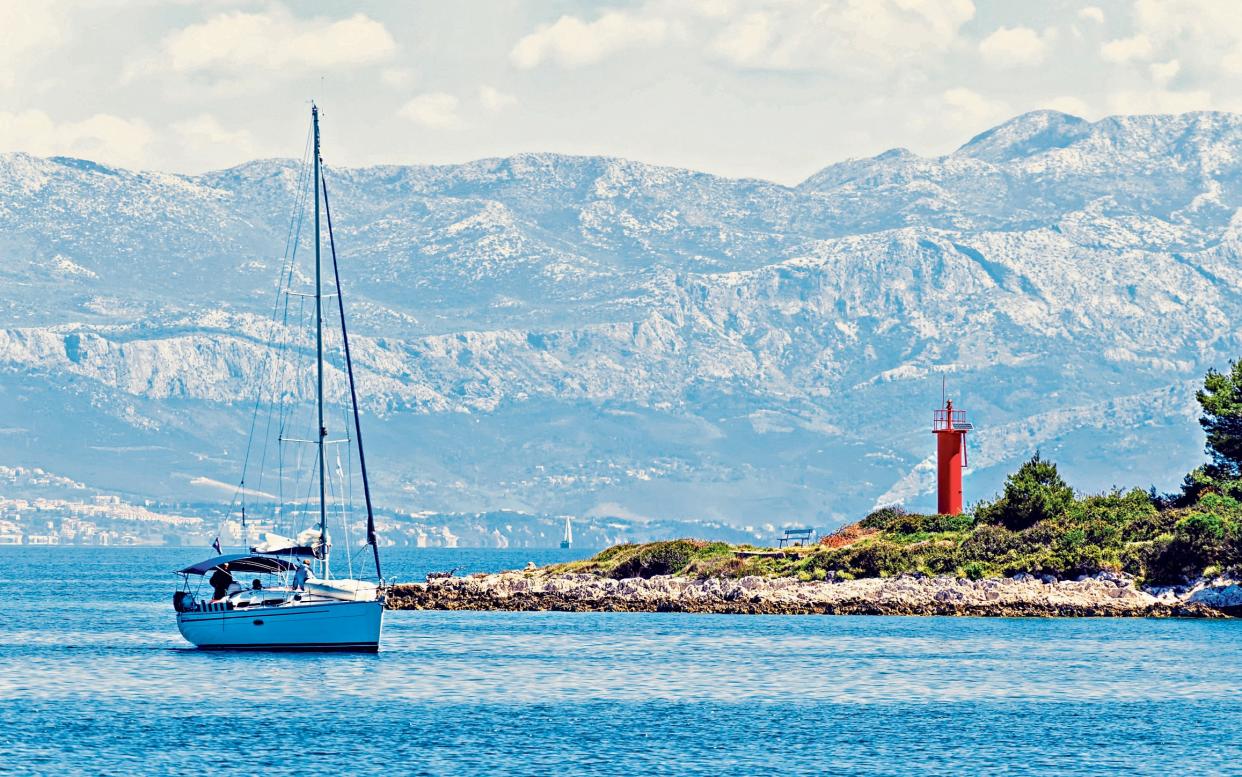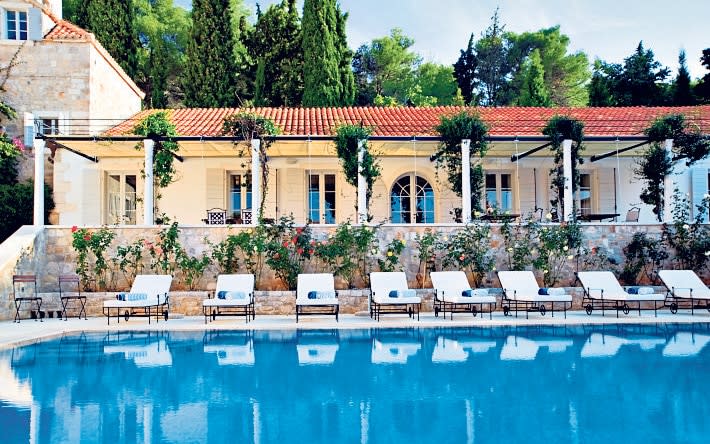The forgotten Croatian island that offers a perfect post-lockdown escape

It’s not hard to spot Solta. People sitting in the cafés along Split’s Riva waterfront, nine nautical miles away, can see this compact Croatian island plain as day. But, conversely, it’s easy to miss – particularly when it’s next door to two of Croatia’s busiest islands, Hvar and Brac.
Because Croatia clamped down hard and early during the coronavirus pandemic, it’s been open to tourists since May – although Hvar and Brac are still a quiet shadow of their former lively selves. Peaceful little Solta, however, is as sleepy as ever.
It’s an unknown quantity for most British visitors, but is seen by locals as a suburb of Split. If only all suburbs had pebbly coves, olive groves, vineyards, blue-green Adriatic waters and the languid atmosphere that makes the Dalmatian coast so appealing. On Solta, the sound of the suburbs comes from cicadas clicking away in the pines.
After a 55-minute ferry ride from Split, I’m in the port of Rogac, about halfway down this 12-mile-long island. I’m heading to the westernmost edge of the island, to the fishing village of Maslinica, where I’m told there are spectacular sunsets. I’m glued to my west-facing balcony in my little apartment in Villa Berg just above the village, marvelling at the glowing sky.

Like the other villages on Solta, Maslinica’s harbour is full of the typically Venetian architecture found along Croatia’s Adriatic coast – nicely weathered limestone houses with green shutter s and terracotta roofs, some with inviting café terraces by the water’s edge. The island’s only hotel, Martinis Marchi, is on the south side of the harbour – a 300-year-old castle that’s now a luxury boutique hotel. It manages the marina, and while occasionally a Sunseeker-sized yacht wedges itself in the harbour, it’s outnumbered by smaller vessels that can’t be bothered to play the “my boat is bigger than yours” game.

It’s in keeping with the unpretentious air of the place. The buzz coming from the waterside bars and restaurants strikes the right lively note – one that matches the unobtrusive folk music played by a quartet of musicians.
It’s an evocative soundtrack to my grilled swordfish at Sakajet restaurant, which comes with a traditional Dalmatian side dish of chard, garlic and potatoes all cooked together. It’s as much a taste of the Adriatic as the grilled fish and shellfish found on all the menus – and just as addictive.

I go on to discover more flavours of Solta, starting in the olive groves outside Maslinica. Mention Croatian olive oil and Istria comes to mind, but hilly Solta, only three miles wide and with a population of 2,000, muscled in on its bigger rival by winning best in class at the New York International Olive Oil Competition in 2019. Even during the Covid-19 lockdown, they managed to pick up another gong this year.
Two award-winning producers from the small Zlatna Soltanka co-op, Tomo Sinovcic and Zlatko Buric, take me on a tour of their olive groves, parts of which have been here for more than 200 years. Sinovcic grins when I ask how winning felt. “We flew around like a bird – without Red Bull,” he says. He and Buric pool their olives, the indigenous levantinka variety, and use only organic methods to produce oil.
“This is a great success for us,” says Buric, “because we are all small growers, only a few hundred trees each. But together we are great.” I’m amused by the fact that “Zlatko” means gold. “You’re the golden man who makes liquid gold,” I say. He laughs. “I suppose I am.” When I have a taste, it is indeed liquid gold, with a rich, peppery kick.
Further south in the village of Gornje Selo, Vicko Kastelanac lays out an appetising spread in the shade of the garden terrace of his Agroturizam Kastelanac. All the olives, tapenade and olive oil he offers in his tastings come from his farm, along with his rosé and red wine made from the dobricić grape found nowhere else. The chocolatey red is robust and an excellent match for the salty tapenade; the rosé’s lightness and freshness give some of Provence’s rosés a run for their money. You have to come to the island to taste it, which is no hardship.
From Gornje Selo, I’m well placed to explore some of the beaches on Solta’s southern side. Apart from a solitary sandy cove, Sipkova, near Maslinica, all the beaches are pebbly or rocky. Not being a huge fan of sand, and armed with swimming shoes, I’m very happy with this. My little 50cc rented scooter can just about handle the rocky path down to Stracinska Bay, where pine-covered hills shelter exquisitely clear water.

All along the southern coast, I encounter more secluded coves – Senjska, Jorja, Tatinja – which take a bit of effort to reach along dusty tracks but are worth it. At most, there are a dozen people on the beaches. Unless you’re on your own boat, many visitors stick to the bigger village beaches at Maslinica, Rogac, Stomorska and Necujam. Banje, a cute beach in Rogac, is right by one of the village’s loveliest restaurants, Pasarela, where shaded tables are set on rocky platforms tumbling to the sea. I get the greatest hits on a seafood platter – cuttlefish ink risotto, green tagliatelle with fruits de mer, octopus salad, tuna carpaccio, langoustines, scallops – all beautifully done.
On an island where everyone seems to be pootling around on a boat, it’s not surprising that waterfront dining is rather special. Just south of Maslinica is the deeply indented Sesula Bay, so sheltered that even the dreaded bura wind that sometimes howls down the Adriatic coast can’t get a look-in. I’m at a waterside table at Konoba Sesula, watching boats moor and people scramble on to the little jetty. If they’ve planned it right and ordered a few hours in advance, they could have octopus or veal in a peka, a bell-shaped iron pot that cooks food slowly under hot embers. Not being that organised, I’m more than happy with my huge grilled langoustines with a side of that moreish chard-garlic-potato combo.
It’s only in the eastern village of Stomorska that I get a sense of Solta being even remotely busy, but nothing compared with the crowds usually found in Hvar Town. The harbour hums with summertime sounds of kids on skateboards, families sauntering past restaurants, moored boats with people on deck eating and drinking merrily.
During my time in Solta, I’m repeatedly asked if I’m from one of the 15 Novakovic families that live in Stomorska. No, I say ruefully, my parents were born in Lika. But, after a few days in this seductive place, I am willing to trade the mountains for laid-back island life, Solta style.
How to do it
Jet2 (0333 300 0404; jet2.com) flies from London Stansted to Split from £159 return. Villa Berg (villaberg.eu) has one- and two-bedroom apartments, each sleeping four, from €80 (£72) a night. Scooter hire with Lunaris Rent-a-Scooter in Maslinica (00385 99 645 793; villa-lunaris.com) costs from 198 kuna (£24) per day. Wine tastings at Agroturizam Kastelanac (00385 98 385 376; agroturizamkastelanac.com) cost from 60 kuna per person.


